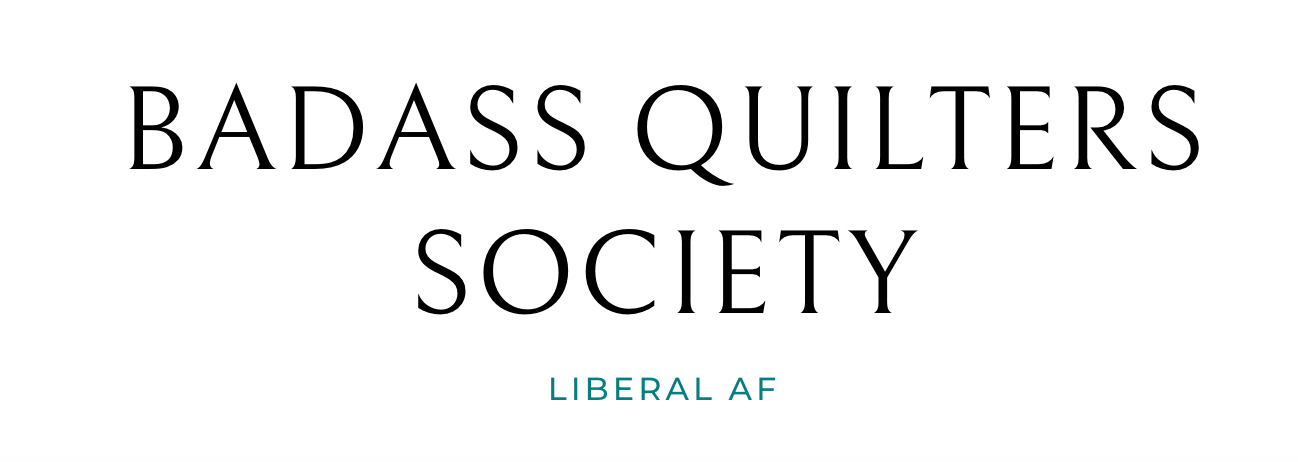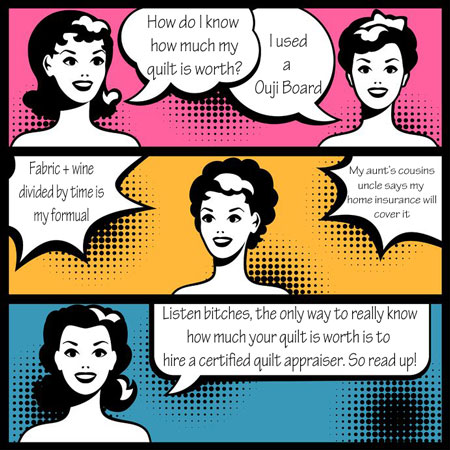She is touching my quilt!
Please welcome back Lori East as she takes us through the next step – Giving your quilt a good look over. This is the part that makes people really nervous but is totally critical to the process and it can’t and should never be done through a photo exchange. Much like a mammogram you need to get up-close and personal to make an accurate assessment of the quilt new or old. If you missed the lead in to this pop over and start HERE
——————————————————————
What happens next? You let the appraiser see your quilt. A reputable appraiser will always insist on
a physical inspection of the piece. Photographs, no matter how close or how still you hold your
iPhone, can never tell the whole story. Make sure that the appraiser will actually examine your quilt
before you hand over your hard-earned money. (Expect to pay between $40 and $50 for a written
appraisal.) Think twice about an appraiser who asks you to send photos or to mail a piece to them.
Quilts have value, remember? You want to know the true value of yours and still own it.
Most often, I will meet you with clipboard in hand, ask you a few questions, and then start making
notes, measuring, and photographing your quilt. But while I’m scribbling away, what am I looking
at? Everything. Really. Big Picture, remember? I am looking at everything from what kind of fabric
you used to how wide your binding is.
(Here I’m sure you’re thinking, “Oh, I see. Quilt Police.”If you are, just stop it.) A lot of clients get skittery when they
bring me something new to appraise,
worrying that I’m going to notice that all their corners aren’t perfect, or that there’s a bump in the
binding. Psssh. I probably will notice, but I’m not going to send you to Remedial Quilting. I see a lot
of quilts and there is one thing I know for sure: Nobody, but nobody, is perfect. Besides, I’m not
looking to point out your mistakes. If I’m wearing my Girl Appraiser clothes, I’m only recording the
facts and determining the value of your quilt, not whether it should have a ribbon. My job is to be
objective, record the facts, and determine the value as it is today. Right here, right now.
If I am looking at a new quilt, some, but not all, of the things I’m looking at are pattern, types of
materials used, techniques employed, and level of workmanship. Not judging, remember? I will also
ask you what shows the quilt has hung in, whether or not it’s been published, and whether or not it’s
won awards. I’ll determine whether or not your piece is an original design or made from a pattern,
and will have someone hold it vertically so I can see its visual impact. All this time I’ll be taking
notes. I rarely want to know how much time you’ve actually put into the quilt because that gets taken
care of in other ways.
You won’t ever see most of the notes I take. The truth is, you couldn’t read them anyway, but you
will get the results in the form of an appraisal package in about three weeks. Why three weeks? Once
I’m home from the show, I’ll take the information I recorded when I had your quilt in hand,
determine the current costs of materials, the going rate for the same techniques at similar levels (for
example, longarm quilting in allover style, done moderately well; amazing hand-quilting; or fusible
machine applique–each one is different and is evaluated separately on its complexity, execution, and
skill), and look at all the discretionary factors that your quilt comprises. Many people assume that I
just add up the cost of materials and the time it took to make a quilt. If it were as easy as that, we
would all be appraisers, and not great ones at that. Through the magic of a calculator and some
wicked math skills, I’ll turn all this information into dollar values, compare the data to what is
happening in the market, and determine the value of your quilt.
The process for appraising an antique quilt is similar, but involves a few other bits of information.
First and most important to an antique textile is condition. This is probably the hardest concept for
most people to understand. If, for example, you find a Grandmother’s Flower Garden from the 1930s
that isn’t in tatters, you might say, “It’s in great shape for its age,” right? Not exactly. When you look
at thousands of quilts, you need a concrete means of identifying condition. I have markers that I note
for different levels of condition so that I can determine where each quilt falls on the scale. It’s easy to
be dazzled by a fun pattern or great color, but personal preference is not part of the equation.
Although I emphasize condition with antique pieces, it’s important with new ones too. Opening up a
quilt, whether new or old, and having cat hair, funky smells, or bugs–dead or alive–spring out at
me like some textilian jack-in-the-box is not my idea of fun. And yes, it happens. If you’re concerned
about smells in an antique quilt, ask me. Otherwise, remove the cat hair, shake the spiders out, and
then come see me. We’ll all be happier. Oh, and please don’t wash an antique piece until we’ve had a
chance to talk. I’ve seen far too many pieces ruined by a person’s desire to clean something.
As with new quilts, I’ll look at the fabrics, in this case to see how old your piece is. Fabric dating is
usually the first thing would-be appraisers want to know about, and the subject of textile history
most learn first. While I can’t tell you that a quilt was finished on Saturday, April 13, 1922, I can get
pretty close, at least within a few years. I’ll also look at how the quilt was made, determine the
pattern, note the level of workmanship, and see if there are any surprises (like a polyester batting in an
1860s quilt or red acrylic yarn ties in a 1900 comforter. Both, if you’re wondering, indicate that
the piece was finished long after the top was made.) It’s crucial to understand the trends, techniques,
and regional variations in quiltmaking over the last couple of hundred years, and how all of these
things fit into social and political history before you can determine what the data means for the value
of a textile. Yeah, it’s like being back in school, but with way cooler tools than textbooks. Every
quilt is its own puzzle.
If you know it, it’s helpful to note a quilt’s provenance. (What’s that, you say? Provenance. Say it:
Proh-ve-nonce. Sit up straight and say it like you’re French. There you go.) Provenance is a fancy
word for the quilt’s story, who made it, where it’s been in its life, and how you came to own it. While
provenance doesn’t usually do a lot for value, to me it’s the real heart of a quilt’s existence. The story
of its life. Quilts do tell stories. This is one thing that really keeps me in love with what I do, learning
the stories and the people behind the quilts. Each and every one is different and they are all
fascinating. Some pieces, because of a variety of circumstances, can’t tell their stories. That’s sad.
And this is why you need to label your work. It’s your gift to the future.
So now you have some of the pieces of the Big Picture of quilt appraisals. You understand that you
need an appraisal because quilts have value and because stuff happens. You know that what kind of
appraisal you ask for depends on what you plan to do with the piece. You’ve learned how to find
someone qualified to do the job, and what to expect when the time comes. So what are you waiting
for?
To learn more about Lori and her adventures as Girl Appraiser, and sometimes as fringehomeschool-mom-who-quilts-and-knits-and-drinks-too-much-coffee,
visit her website at
LoriEast.com or her Facebook page, Lori East Quilts.



